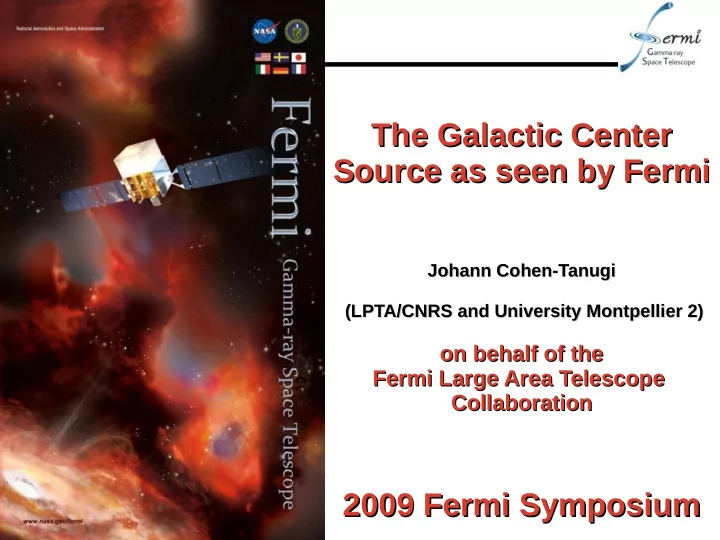

The Galactic Center The Galactic Center Source as seen by Fermi Source as seen by Fermi Johann Cohen-Tanugi Johann Cohen-Tanugi (LPTA/CNRS and University Montpellier 2) (LPTA/CNRS and University Montpellier 2) on behalf of the on behalf of the Fermi Large Area Telescope Fermi Large Area Telescope Collaboration Collaboration 2009 Fermi Symposium 2009 Fermi Symposium
Hell's Kitchen Hell's Kitchen • One of the most complex regions in the sky! • A huge pp emissivity due to CRs streaming through very dense clouds (CMZ) • Electrons too (IC with local ISRF) • Many possible γ -ray emitters (SNR, pulsars, binaries....) 0.5° at 1GeV
Local Source classes of possible interest Local Source classes of possible interest • Deneva et al. 09 : 3 pulsars detected in the close vicinity of SgrA*. Inferred population of ~2000 active radio pulsars! • 2 famous star clusters (Arches and Quintuplet) • LMXBs around (see e.g. Del Santo et al. 2006) • SNRs and PWNs (see e.g. Johnson et al. 2009) • GAS! Discussed in Seth Digel's plenary talk Mouse pulsar PSRJ1747-2958 detected in γ -rays! Abdo et al. 09, submitted to ApJ arxiv:0910.1608
H.E.S.S view of the GC G0.9+0.1 HESS J1745-290
Recent H.E.S.S. results • Van Eldik et al. 2007 – Improved pointing analysis : 30''->6'' – Sgr A East excluded at 95% C.L. • Remaining candidates – SgrA* – PWN cand. G359.95-0.04 (Wang et al. 06) – others.... • Aharonian et al. 2009 – 3 year analysis shows cutoff – No variability found – E cut ~20TeV Φ 0 =(2.55+/-0.06)e -12 TeV -1 cm -2 s -1 – Γ =2.1 +/- 0.04
The LAT BSL sources within 10° of the GC The LAT BSL sources within 10° of the GC • Bright Source List (BSL): 3 month LAT catalog of highly significant sources (TS>100) : Abdo et al., ApJS 183, 46-66, 2009 • 9 month skymap in cts/s/pixel with 95% C.L. error circles for BSL sources (0.3° pixel) • We are contemplating a vastly more inhabited landscape after 11 mths and TS>25... • 0FGLJ1746.0-2900 detected at 36 σ , position=(266.506, −29.005,0.068) Front Evts >200 MeV + Back Evts > 400 MeV Log scale 0.3° pixel
Localization and variability of the BSL source • Image is H.E.S.S. after source removal • Diamond is SgrA*, with the 2 most recent H.E.S.S. Localizations 0.1 • Formally inconsistent with the BSL position • EGRET reanalysis (Dingus&Hooper 04) not consistent either with BSL! • Still need more data to understand systematic biases.... • Variability studies in the BSL paper finds marginal variability – Chi2 based, PWL flux (200MeV to 100GeV) computed per week – Threshold=24.7, (alpha error=1% ~ 2 false positives in the 205 BSL sources) – Key to association and interpretation of the GC source (think DM....)
11 month localization • La Rosa et al. 90cm radio map • Cross : SgrA* • 11 month error is 95% C.L. With 1.2 scale factor and 27” systematics added in quadrature • 11 month analysis does not not confirm the BSL result : H.E.S.S. and LAT sources are spatially coincident • SgrA East is not excluded by the LAT, but not favored either. PRELIMINARY
Preliminary Spectral considerations • 11 month LAT flux significantly lower than EGRET analysis (Mayer-Hasselwander) – Weak evidence for a SED peak below 1 GeV – Harder spectrum than previously modeled • Matching H.E.S.S. Spectrum (single source hypothesis) requires – Either a high-energy break – Or a cutoff................ under study Jeltema & Profumo 08 PRELIMINARY Curvature-IC model BH-PWN model
Source Variability • Integrated flux from 100 MeV to PRELIMINARY 100 GeV • Dashed line is the 11 month average • BSL Mentioned possible marginal variability – Not confirmed, within errors, on a ~monthly scale by 11 month LAT data • Further analysis ongoing
Summary of Status Summary of Status • LAT analysis ongoing in this very difficult region of the sky – Improved modeling of the background – Checks for systematics – Robustness of the analysis against possible unresolved sources, imperfect description of the gas distribution, etc... • Preliminary features of the central bright excess emission – Compatible with a point source, in positional coincidence with the H.E.S.S. source (but still large error radius) – Flux somewhat lower than EGRET, with no obvious break above 1 GeV, and no variability over monthly scale • APJL in preparation within the LAT collaboration
Dark Matter Dark Matter • Galactic center is well-known as a potential source of gamma- rays related to decay of dark-matter particles • See poster by Vincenzo Vitale • For the LAT data, we need a very accurate background model to assess upper limits, and a very strong case to discard other possible astrophysical sources in case of detection.... • .... especially now that the 'GeV excess' is not there anymore: Abdo et al., submitted to ApJ
Recommend
More recommend